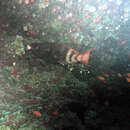Life Cycle
provided by Fishbase
Oviparous, distinct pairing during breeding (Ref. 205).
Biology
provided by Fishbase
Inhabits steep outer reef slopes (Ref. 9710). Solitary and wary species (Ref. 9710). Caught with nets and other kinds of artisanal gear. Mainly sold fresh.
Comprehensive Description
provided by Smithsonian Contributions to Zoology
Scarus caudofasciatus (Günther)
Pseudoscarus caudofasciatus Günther, 1862, p. 238.—Playfair and Günther, 1866, p. 108.
Callyodon caudofasciatus.—Smith, 1956, p. 10; 1959, pp. 271, 279.
Scarus atropectoralis Schultz, 1958, p. 79, pl. 15A.
Characterized by having 6 median predorsal scales, 3 rows of scales on cheek, with 2 scales in ventral row, ii,13 pectoral fin rays, lips not covering white teeth; pectoral fin base black, general coloration reddish brown, overlaid with 5 dusky vertical bars on side of body extending to midventral line of body; distal edges of median fins same coloration as rest of fin.
Dr. H. Steinitz sent one specimen, 149 mm in standard length, from the Red Sea, which has helped to confirm the opinion of Smith (1958, p. 271) that S. atropectoralis Schultz is a synonym of this species.
Other specimens: IIOE Sta. RS–40, FT–19, 8 December 1964, Amirantes, 1 spec, 121 mm; IIOE Sta. RS–41, KA39, 8 December 1964, Amirantes, 2 spec., 101–139 mm; IIOE Sta. JR–75, 17 February 1964, Madagascar 1 spec., 69 mm.
The above-listed specimens, ranging from 69 to 139 mm in standard length, do not show the vertical dark bars but appear to belong to this species. The base of the pectoral is blackish and the edges of the scales on the side of the body are brown, giving a netlike appearance much like the 149-mm specimen from the Red Sea.
RANGE.—Western Pacific Ocean, western Indian Ocean, and Red Sea.
- bibliographic citation
- Schultz, Leonard P. 1969. "The taxonomic status of the controversial genera and species of parrotfishes with a descriptive list (family Scardiae)." Smithsonian Contributions to Zoology. 1-49. https://doi.org/10.5479/si.00810282.17
Comprehensive Description
provided by Smithsonian Contributions to Zoology
Scarus rubrofasciatus (Smith)
Callyodon rubrofasciatus Smith, 1955, p. 934; 1956, p. 10, pl. 43I; 1959, p. 279, pl. 43I.
Scarus rubrofasciatus.—Schultz, 1958, p. 79, pl. 14E.
Pseudoscarus caudofasciatus [not Günther, 1862].—Günther, 1909, pl. 153A.
Characterized by having 6 or 7 predorsal scales, 3 series of scales on cheek, 2 to 4 scales in lower row, and ii,13 pectoral rays; lips not covering white teeth. Anterior half of body dark, with 3 vertical dark bars posteriorly; Smith’s Plate 43I shows the dark areas as brown and light areas red.
The IIOE collected 4 specimens, USNM 202667 (Sta. 34A, near Nossi-Bè, Madagascar, 13°24′23″S, and 48°12′12″E, 16 January 1964). They vary in standard length from 155 to 245 mm, and are characterized by 6 or 7 predorsal scales, 3 rows of scales on cheek with 1 or 2 scales in ventral row, and ii,13 pectoral rays. Coloration in life was a plain reddish brown, distal margins of dorsal and anal fins are edged with a light brown (in alcohol), and at base of each of these fins is a narrow dark streak. In all four specimens, the scale just posterior to lower edge of pectoral base is blackish and another scale in same position at upper edge of pectoral fin base is dusky in alcohol. Caudal lobes are slightly produced except in smallest specimens.
Their identification is tentative depending on a study of a large series of specimens in the field.
RANGE.—Western Indian Ocean.
- bibliographic citation
- Schultz, Leonard P. 1969. "The taxonomic status of the controversial genera and species of parrotfishes with a descriptive list (family Scardiae)." Smithsonian Contributions to Zoology. 1-49. https://doi.org/10.5479/si.00810282.17
Description
provided by World Register of Marine Species
Appears to inhabit outer reefs. Not abundant. Also caught with nets and other kinds of artisanal gear. Sold mostly fresh in markets.
Froese, R. & D. Pauly (Editors). (2023). FishBase. World Wide Web electronic publication. version (02/2023).
- license
- cc-by-4.0
- copyright
- WoRMS Editorial Board

